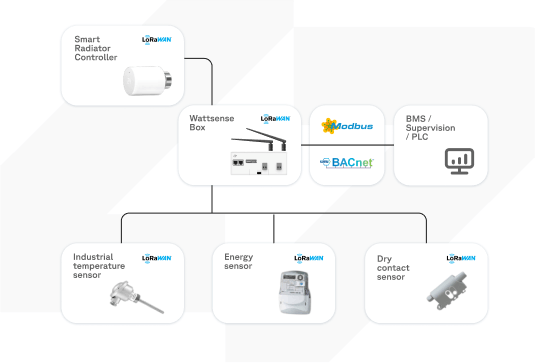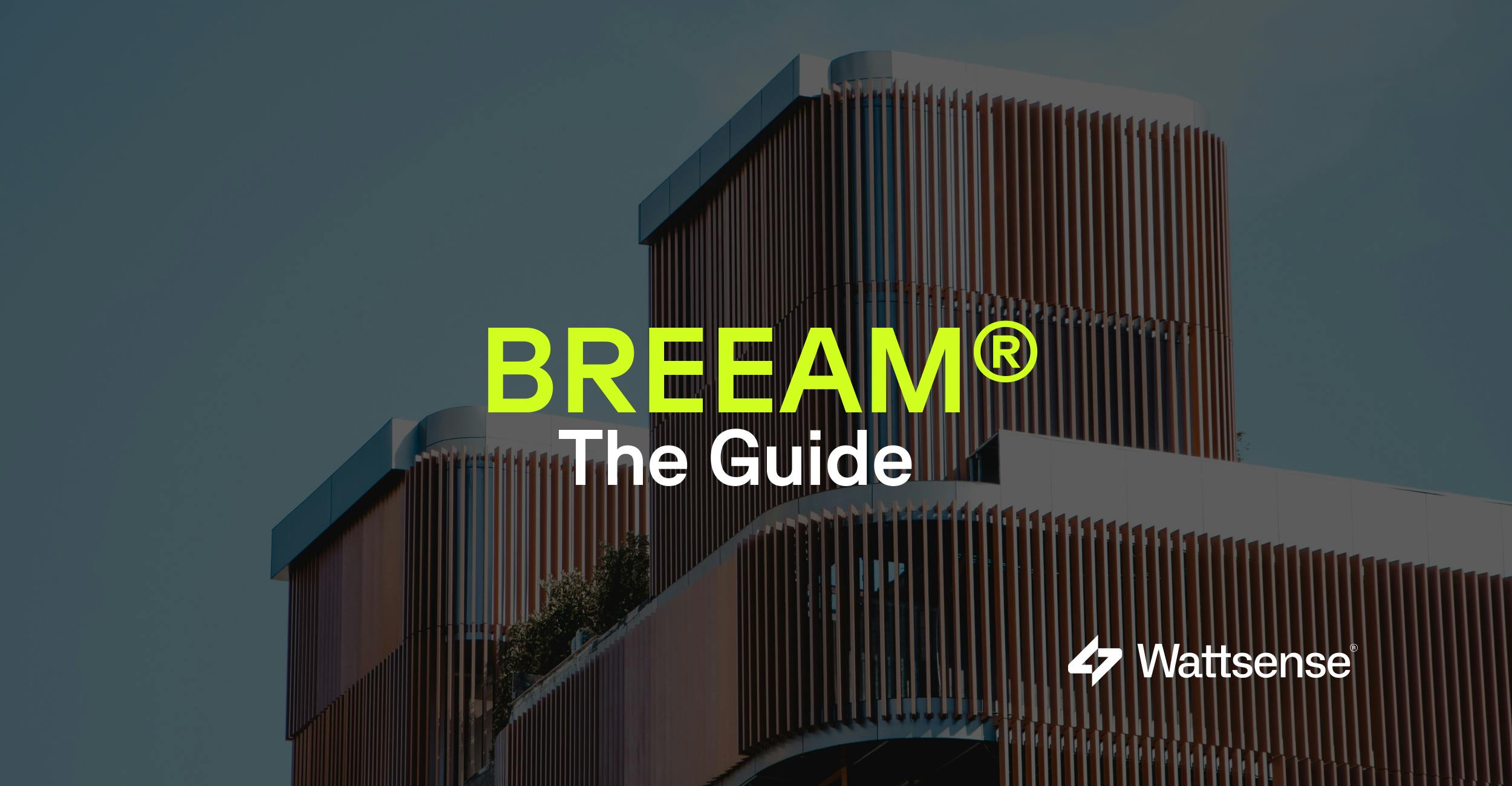IoT in Smart Buildings: Benefits, Use Cases, and Tips

The emergence of the Internet of Things (IoT) heralds a new era in building management.
IoT presents numerous opportunities to enhance the management of commercial, industrial, and residential properties.
These technologies not only revolutionize how we interact with our living and working spaces but also play a pivotal role in optimizing energy efficiency, cutting operational costs, and improving occupant comfort.
In this article, we'll delve into how IoT is reshaping the building landscape, making it simpler, more sustainable, and cost-effective to modernize the global real estate portfolio.
Wattsense's connectivity solution offers an innovative pathway to seamlessly and swiftly integrate IoT into any building. Find out more here.
IoT, a Game-Changer for Smart Building Management
Leveraging IoT in the building sector entails deploying connected devices, such as IoT sensors and equipment, throughout various sections of a building or on technical systems. These IoT devices primarily gather and transmit diverse data, serving as a vital conduit for relaying pertinent information.
By communicating through IoT gateways with management systems like a BMS (Building Management System), a BOS (Building Operating System), a BIS (Building Information System), or an EMS (Energy Management System), these IoT devices streamline essential functions such as data visualization, analysis, control, and prediction. These functionalities contribute to elevating the intelligence and efficiency of buildings.
Integration of IoT in buildings plays a crucial role in evolving methods of supervision and management of properties. It gradually transforms traditional buildings into intelligent structures capable of dynamically and efficiently meeting user needs and environmental challenges.
How does IoT work in a Smart Building?
IoT sensors and equipment in the building sector encompass a wide range of devices designed to measure and control various aspects of the built environment. Among these are:
- Temperature sensors, monitor and regulate heat in indoor spaces.
- Electricity meters and sub-meters are crucial for tracking energy consumption.
- Occupancy and CO2 sensors are essential for managing indoor air quality and optimizing space utilization.
- Volatile organic compound (VOC) sensors and thermostat valves also contribute to improving air quality and thermal comfort.
- Brightness sensors adjust lighting according to real needs, saving energy while enhancing occupants' experience.
These sensors collect and transmit operational data to a central analysis and control platform via gateways or connectivity solutions like Wattsense technology.
Integration of IoT in buildings plays a crucial role in evolving methods of supervision and management of properties. It gradually transforms traditional buildings into intelligent structures capable of dynamically and efficiently meeting user needs and environmental challenges.

The Internet of Things, the cornerstone of smart buildings for property managers
The integration of these wireless communicating objects offers numerous advantages, making it a true revolution for property portfolio managers.
To read: Turn your Building into a Smart Building: 9 benefits
Modernizing without heavy construction
The Internet of Things enables modernizing existing building technical systems without costly renovation or construction work. Essentially, it involves adding IoT sensors to existing equipment (boilers, HVAC, air conditioning, lighting, etc.) without replacing all installations.

This retrofitting approach avoids equipment replacement, significantly reducing the required investments. Buildings are modernized affordably to become connected and smart. This solution is ideal for tertiary real estate portfolios subject to the BACS decree.
Recovering data when wired connections are impossible
The use of wireless IoT sensors proves particularly advantageous in situations where the architecture or physical constraints of a building make it difficult, if not impossible, to install wired systems.
To read: Monitoring Building Equipment with LoRaWAN: A Solution to Wiring Problems
Centralizing Data
IoT makes it easier to access equipment data and convert local data to centralize all data gathered by different equipment and systems in the building onto a single platform. This unified collection of operating data eliminates information silos, providing an essential overview of the building to optimize its management. Cross-referencing this data from multiple sources also aids in anticipating malfunctions.
Supervising, Anticipating, and Adapting: IoT Use Cases in Real Estate
There are numerous IoT applications to optimize smart buildings.
Enhancing Smart Building Energy Performance
IoT facilitates detailed monitoring of energy consumption. By connecting meters and sensors to Energy Management Systems (EMS), it’s possible to have an overview and monitor the overall consumption of the building and specific areas or equipment (lighting, heating, air conditioning, utilities, etc.). These detailed insights highlight areas where energy savings are possible. Actions are then prioritized based on their return on investment. IoT provides all the tools to effectively reduce energy bills.
Compliance with Regulations
To comply with the requirements of the BACS decree or other government regulations, building managers can implement measurement and energy monitoring systems based on IoT technologies. IoT, by facilitating connectivity, makes it easy to upgrade or install a building management system and improve building energy performance.
Optimizing Building Equipment Maintenance
The use of IoT technologies also facilitates predictive maintenance of technical equipment. Real-time operating data collection allows for setting up alarms to anticipate anomalies before they cause breakdowns. Technicians can intervene at the right time, reducing maintenance costs.
IoT enables a shift from corrective maintenance (fixing what’s broken) to predictive maintenance (anticipating breakdowns). Collected data highlights equipment showing signs of wear or malfunction (such as abnormal motor vibrations). Technicians can then intervene before breakdowns occur, which are less frequent, shorter, and less costly. IoT greatly optimizes building maintenance costs.
Enhancing Occupant Comfort
Comfort management also plays a central role. By installing sensors to measure temperature, humidity, CO2 levels, brightness, and presence, and connecting them to a management system, building managers can adjust environmental conditions according to specific occupant needs, room by room. The use of IoT sensors allows for dynamic control of comfort parameters (temperature, humidity, air quality, etc.) tailored to occupants' needs for personalized comfort.
Automating Tedious Tasks
Combining IoT sensors and actuators with local automation or a cloud automation service (IFTTT or NodeRed) is very effective for setting up logic, such as regulating comfort parameters (temperature, humidity, air quality, brightness, among others) based on the actual occupancy of different spaces. These tasks are simplified to allow teams to focus on higher-value missions.
Real-Time Supervision and Response
IoT also facilitates real-time supervision of equipment and ambient conditions in the building through the multiple data sent by sensors. Any abnormal event is instantly detected, such as local overheating, under-voltage, or excessive humidity. Through management and supervision systems, managers are immediately alerted, wherever they are. They can then quickly react by adjusting parameters remotely or sending a team on-site. This quick intervention capability prevents minor malfunctions from escalating into major incidents.
Choosing the Right IoT Equipment for a Successful Smart Building
To succeed in deploying the Internet of Things within a real estate portfolio, several criteria should be considered when choosing technological solutions:
- Interoperability: It's essential to choose interoperable IoT solutions based on open standards, not closed proprietary technologies. This avoids technological silos, where equipment and data are isolated. Interoperability facilitates the integration of new sensors and connected devices as needs evolve. It provides more flexibility to evolve installations over time.
- Choosing the right IoT communication protocol: The LoRaWAN protocol is particularly suitable for connectivity issues in smart buildings due to its long range, capable of covering an entire building. Its low energy consumption also makes it a sustainable choice. Its simplified deployment makes it ideal for real estate portfolios. Similarly, its use in both cloud and local solutions makes it an ideal protocol for those looking to evolve their installation step-by-step
To read: LoRaWAN Protocol: Everything You Need to Know
- Data security is paramount for cybersecurity and to guard against cyberattacks that can disrupt building installations and activities. It's crucial to ensure that data is encrypted, and that authentication and access permissions are strictly managed. Active security monitoring and regular updates are necessary.
- Adaptation to needs and use cases: IoT technologies must be tailored to the specific needs of the building and the intended use cases for effective deployment. There's no need to add and pay for sensors that aren't needed. Prior auditing of requirements and detailed specifications helps choose IoT solutions that bring the most value to a tertiary building.
- Limiting ecological impact: In this regard, it's important not to oversize IoT installations and sensor fleets to minimize ecological impact. Sharing objects is essential where possible, avoiding sensor duplicates. Additionally, materials should be easily recyclable at the end of their life cycle.
By integrating these different criteria, building managers make the right technological choices for a successful IoT project.”
To succeed in your digital transformation through IoT and optimize your real estate portfolio, trust in the services and expertise of Wattsense. Our team is available to assist you in deploying these connected devices for the performance of your buildings.
Connected Buildings for Enhanced Intelligence
IoT doesn't operate in isolation. On the contrary, to fully leverage the data collected, IoT must integrate with other emerging technologies like Artificial Intelligence (AI), big data, and cloud computing.
Artificial Intelligence
AI enriches IoT use cases in buildings. Machine learning algorithms can detect anomalies in collected data to anticipate malfunctions. AI also optimizes energy management and efficiency.
Big Data and Cloud
Processing massive data generated by connected devices requires the combined use of big data and the cloud. The cloud offers high computing and storage capabilities for real-time fine analysis. Cloud-based solutions allow for remote updating of software and applications without on-site intervention. Managers can quickly benefit from the latest optimizations and features to adapt their tools to changing needs.
Therefore, by combining IoT, AI, and big data, building managers can turn raw data into actionable insights to create value. IoT must thus be part of a comprehensive technological approach.
"In summary, the application of IoT in buildings focuses on the use of IoT sensors and equipment. These devices play a crucial role in communication, as they collect and transmit data. When integrated into management systems, these sensors and equipment not only allow for data visualization but also for in-depth analysis, system control, and prediction of various needs or problems."
"This synergy between IoT and management systems is fundamental to transforming a traditional building into an intelligent structure."
In Conclusion
The adoption of IoT in the real estate sector opens up a realm of possibilities for more efficient and intelligent building management. By connecting IoT sensors and equipment to advanced management systems, building managers can not only optimize energy efficiency but also enhance occupant comfort and simplify maintenance.
Wireless connectivity and system interoperability offer unparalleled flexibility, especially in buildings where wired systems installation is impractical. Centralizing operational data eliminates information silos, allowing for comprehensive supervision and rapid response to anomalies.
IoT is not just a technological addition; it's a strategic transformation lever that makes buildings smarter and more efficient. By adopting an integrated approach and choosing the right tools, property managers can not only address current challenges but also effectively prepare for the future of the real estate sector.
Technologies like the connectivity solution offered by Wattsense enable seamless integration of IoT, making buildings more responsive and adaptive to constantly evolving needs. Feel free to request a demonstration of our solution to learn more feel free to request a demonstration of our solution to learn more.
Want to learn more about the Wattsense connectivity solution?
Discover our solutionContinue reading




